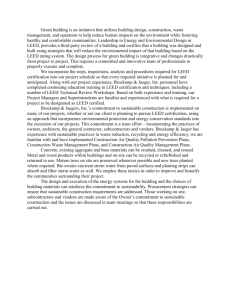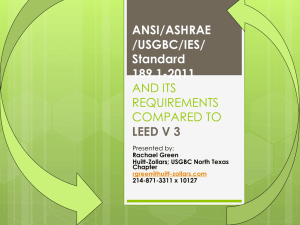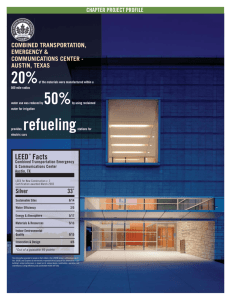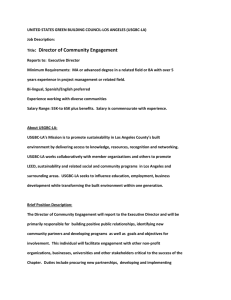Presentation - Building Commissioning Association
advertisement
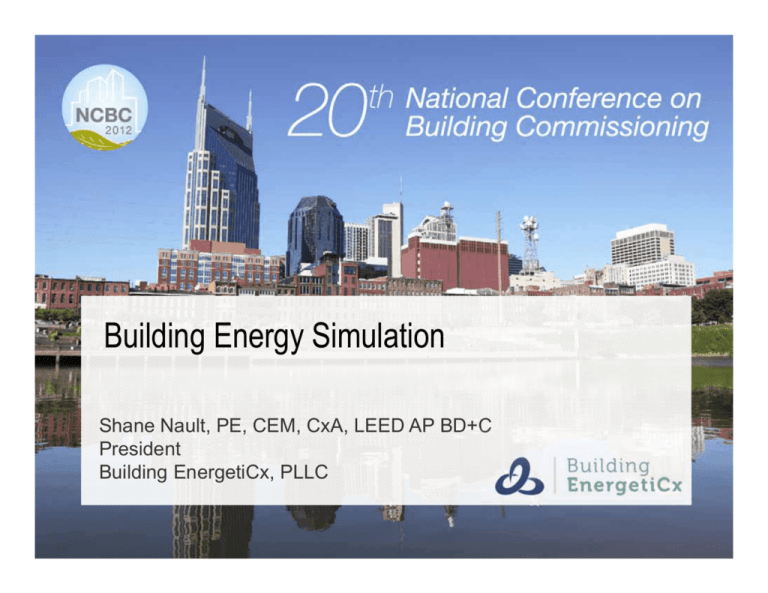
Building Energy Simulation Shane Nault, PE, CEM, CxA, LEED AP BD+C President Building EnergetiCx, PLLC AIA Quality Assurance The Building Commissioning Association is a Registered Provider with The American Institute of Architects Continuing Education Systems (AIA/CES). Credit(s) earned on completion of this program will be reported to AIA/CES for AIA members. Certificates of Completion for both AIA members and non-AIA members are available upon request. This program is registered with AIA/CES for continuing professional education. As such, it does not include content that may be deemed or construed to be an approval or endorsement by the AIA of any material of construction or any method or manner of handling, using, distributing, or dealing in any material or product. Questions related to specific materials, methods, and services will be addressed at the conclusion of this presentation. Course Description With the increasing improvement on building energy efficiency and Net Zero goals, building energy simulations are becoming the standard on more projects. This course will provide a basic understanding of the building energy simulation process and the two basic types of applications. We will review the energy simulation tools available. Finally we will review some of the requirements for LEED energy modeling. Learning Objectives At the end of this session, participants will be able to: 1. Participants will understand the building energy simulation process and different software tools available. 2. Participants will be able to identify the benefits of building energy simulation. 3. Participants will be to prepare future predictive and data driven building energy models to evaluate system design performance and energy conservation measures. 4. Participants will be able to navigate through the basics of LEED building energy modeling and ASHRAE Standard 90.1 requirements. Where Are Building Energy Simulations Required? LEED® Rating System • EAp2 – Energy and Atmosphere Prerequisite 2 – Minimum Energy Performance (AHRAE 90.1-2007) • EAc1 – Energy and Atmosphere Credit 1 – Optimize Energy Performance Energy Assessments / Existing Building Cx • Not required, but may be necessary to evaluate energy saving opportunities • Compare Energy Conservation Measures (ECMs) State Regulations / Building Codes • Compare proposed design to ASHRAE Standard 90.1 baseline (% Improvement) • IECC 2012 – Total Building Performance (IGCC) 179d - Energy Efficient Commercial Bldg Deduction • 50% greater energy efficiency standard than ASHRAE Standard 90.1-2001 • Can model building envelope, HVAC, and Lighting individually Building Energy Simulation What is It? Uses a “mathematical model as a description of a behavior of a system” • Input Variables (Climate) • System parameters / properties (building) • Output (Energy Use) • Simulation using software to estimate • • end-use energy usage and demand • Output Reports / Data Building Loads Energy Consumption Economic Analysis Basic System Architect Engineer Owner Energy Simulation Perspectives Two Approaches Data-Driven Simulation • Existing Buildings • Develop Baseline Forward Simulation • Design Based • Prediction of future Benefits of Building Energy Simulations Decision Based Design Tool Benefits Comparison Tool Prediction of Energy Usage Building Energy Simulation Software DOE Qualified Software • • • • • DOE-2.2 Energy Gauge Energy Plus eQuest Hourly Analysis Program (Carrier HAP) • IES – Virtual Environment • Trace 700 (Trane) http://www1.eere.energy.gov/buildings/qualified_software.html DOE 2.2 Energy Gauge Energy Plus eQuest HAP IES VE-Pro Trace 700 Software Comparison 8,760 hrs / Yr Yes Yes Yes Yes Yes Yes Yes ASHRAE 90.1 Yes Yes Yes Yes Yes Yes Yes > 10 Zones Yes Yes Yes Yes Yes Yes Yes Hourly Loads Yes Yes Yes Yes Yes Yes Yes CAD Import No No Yes Yes Yes Yes Yes eQuest No Yes(1) Yes No Yes No Graphical Reports No No No Yes Yes Yes Yes Automatic LEED Baseline No Yes No No No(3) No(2) No LEED Reports No Yes No No Yes Yes Yes Free/$650 $949 Free Free $1,495 $3,000 $1,995 Graphical Input Cost (1) Through third party software (2) Developing now. (3) Partial Energy Plus Free Tool Graphical Interface OpenStudio Google SketchUp Other Simulation Software Autodesk Green Building Studio • • • • Web-Based Energy Analysis Software Whole Building Energy Analysis Integrates with Revit (gbXML) Evaluates Natural Ventilation • Provides ENERGY STAR® Score • Water Usage Other Simulation Software Ecotect Analysis • Sustainable Building Design Software • Visualization Tool • Thermal Performance • Daylighting • Shadows • Solar Radiation • PV Collection Energy Simulation Principles 1. Reduce Load 2. Harvest Site Attributes 3. Recover Waste Energy 4. Improve System Efficiency Energy Simulation Process Load Analysis Systems Analysis Plant Analysis Economic Analysis Load Analysis - Location Project Location Thermal Zone Weather Library • Temperatures (drybulb / web-bulb) • Cloud Factor • Wind Speed • Pressure Load Analysis – Building Input Building Envelope • • • • • Walls Roofs Floors Windows / Doors Dimensions (length, width, height) Building Area • Zoning Helpful Information • Floor Plans, Elevations, Sections Load Analysis – Internal Loads People Lights Equipment • Density • Activity Level • Lighting Power Density • Internal / External • Plug Loads • Process Loads Load Analysis - Ventilation Ventilation and Exhaust Requirements • ASHRAE Standard 62.1 Occupancy CFM / Person CFM / sf # / 1000 sf 7.5 0.06 65 Office Space 5 0.06 7 Conference / Meeting 5 0.06 50 Corridors 0 0.06 0 Storage Rooms 0 0.12 0 Lecture Classroom Load Analysis - Behavior Schedules • • • • • • Overall Building Occupancy Misc. Equipment Lighting Thermostats HVAC Systems Environmental Requirements • Temperature / Humidity Typical Building Loads Cooling Load (sf/ton) Building Type Low Average High Education 240 185 150 Hospital1 275 220 165 Hotel 350 300 220 Office 360 280 190 Restaurant2 150 120 100 1. Patient Rooms 2. Medium ASHRAE Pocket Guide for Air Conditioning, Heating, Ventilation, and Refrigeration - 2001 System Analysis – System Type Variable Air Volume Constant Air Volume • Others System Types Include – Chilled Beams, Displacement, Underfloor, Induction, Fan Coil, PTAC, Heat Pumps. System Analysis – System Options Economizer • Dry Bulb • Enthalpy Energy Recovery Control Strategies • Water to Water • Air to Air • Air to Water • Night Set Back • Demand Control Ventilation Plant Analysis Equipment Type (Source) • Chilled Water, Heating Water, Steam, Geothermal, Dx Fuel Type • Electric, Gas, Water, Purchased Performance Characteristic • Efficiencies Load Assignment Economic Analysis Utility Rate Structures Economic Factors • Interest Rates ( Tax / Inflation) Economic Costs • First Cost, Maintenance Cost, Replacement Cost Life Cycle Analysis Data Driven Simulations Existing Building Commissioning ECM Evaluation Measurement and Verification Developing the Baseline Establish Baseline Measureable • Energy Utilization Index (EUI) • Energy Cost Index (ECI) • Cost of Goods Produced • Carbon Reduction Building Energy Performance Energy Use Index Energy Cost Index “We can’t manage what we don’t measure” Building Energy Benchmark Evaluate Utility Bills • (3 Years Minimum) Establish Building Performance • Energy Star • CBECS Baseline Building EUI 87,000 Btu/sf-yr 75,195 Btu/sf-yr ECI $1.48 /sf $1.36 /sf Baseline Energy Simulation Load Analysis Systems Analysis Plant Analysis Verify Building Operation Schedule Verify Control Strategies Observe Plug Loads Verify Utility Rate Schedule Economic Analysis Energy Simulation - Accuracy Compare Baseline Simulation to Actual (This May Take Several Iterations) +10% -10% Energy Conservation Measures ECM Description Cost Potential Savings Simple Payback Priority C1 Occupancy Schedules 1 1 1 1 C2 Hot Water Reset 1 1 1 1 C3 Economizer 1 1 1 1 C4 SAT Reset 1 1 1 1 H1 Replace CT 3 2 2 2 H2 Add VFD 2 1 1 1 Alternative Evaluations • Build Alternatives (one at a time) • Compare Energy Usage • Economic Analysis ECM Cost Energy Savings Cost Savings Simple Payback Priority C1 $1,500 106,607 kWh $8,078 0.2 Yrs 1 C7 $1,000 83,757 kWh $6,332 0.2 Yrs 1 H6 $500 3,374 kWh $255 1.9 Yrs 1 W1 $850 43,928 gal $515 1.7 Yrs 1 L1 $2,350 6,224 kWh $471 4.2 Yrs 1 Measurement and Verification Continuous Performance Monitoring Proactive Energy Management Operational Training Accountability Forward Simulation Commissioning Providers and Energy Simulations Synergies with Commissioning When do you start the Energy Simulation? Energy Simulation In Phases Conceptual Design •Site Location •Building Massing •Building Orientation •Comparing Alternatives (High Level) •Relatively Accurate Schematic Design •Optimize Focus •Energy Saving Strategies •Evaluate Energy Breakdown •Where to focus efforts Design Development Construction Document •Refine model and systems •Finalize Comparison Project Decision Points Project Progress Design Effort/Effect 1 2 1 2 Predesign Ability to impact cost and functional capabilities Cost of design changes Schematic Design Construction Agency PermitConstruction / Design Development Documents Bidding 39 Graphic originated by Patrick MacLeamy, FAIA LEED® Rating Systems LEED® Categories Sustainable Sites (SS) Water Efficiency (WE) Regional Priority (RP) LEED® Energy and Atmosphere (EA) Innovation in Design (ID) Indoor Environmental Quality (IEQ) Materials and Resources (MR) LEED® NC 2009 vs. LEED® NC 2.2 LEED® NC 2.2 Description LEED® NC 2009 Diff % Possible % of Total Possible % of Total Sustainable Sites (SS) 14 20.3% 26 23.6% 3.4 Water Efficiency (WE) 5 7.3 % 10 9.1% 1.8 Energy and Atmosphere (EA) 17 24.6% 35 31.8% 7.2 Materials and Resources (MR) 13 18.8% 14 12.7% -6.1 Indoor Environmental Quality (IEQ) 15 21.7% 15 13.6% -8.1 Innovative Design (ID) 5 7.3% 6 5.5% -1.8 Regional Priority (RP) 0 0% 4 3.6% 3.6 TOTALS 69 100% 110 100% BONUS POINTS LEED® NC 2012 vs. LEED® NC 2009 LEED® NC 2009 Description LEED® NC 2012 Diff % Possible % of Total Possible % of Total Integrative Process (IP) - - 1 0.9 +0.9 Location Transportation (LT) - - 16 14.5% +14.5 Sustainable Sites (SS) 26 23.6% 10 9.1% -14.5 Water Efficiency (WE) 10 9.1% 11 10% +0.9 Energy and Atmosphere (EA) 35 31.8% 33 30% -1.8 Materials and Resources (MR) 14 12.7% 13 11.8% -0.9 Indoor Environmental Quality (IEQ) 15 13.6% 16 14.5% +0.9 Innovative Design (ID) 6 5.5% 6 5.5% 0 Regional Priority (RP) 4 3.6% 4 3.6% 0 110 100% 110 100% 0 TOTALS LEED® NC Certification Requirements LEED NC 2.2 Level LEED NC 2009 / 2012 Lower Upper Lower Upper Certified 26 32 40 49 Silver 33 38 50 59 Gold 39 51 60 79 Platinum 52 69 80 110 LEED® Energy and Atmosphere – EAp2 Intent • Establish Minimum Level of Energy Efficiency Requirements • Comply with ASHRAE Standard 90.1 - 2007 • Demonstrate a 10% Minimum Energy Reduction Compared to ASHRAE Standard 90.1 - 2007 Compliant Building LEED® Energy and Atmosphere – EAc1 Optimize Energy Performance • Whole Building Energy Simulation (1-19 points) • One point for every 2% reduction in energy cost • Base - 10% New Buildings, 8% Existing Buildings • Prescriptive path -ASHRAE Advanced Energy Design Guides (1 point) • Prescriptive path -Advanced Buildings Core Performance Guide (1-3 points) LEED® Simulation Ins/Outs Baseline (ASHRAE Standard 90.1 – 2007) vs. Proposed Percentage savings based on energy cost NOT actual energy consumption 25% of total load must be process load (or plug load) Include site lighting, domestic hot water systems, elevators, kitchen hoods Identify different spaces (IT Closets / Usage) Can use state average utility rates published by the DOE Treat existing Central Utility Plant as purchased chilled water, must be cost Neutral Modeling a large Campus - Each building must meet LEED® independently ASHRAE Standard 90.1 Components Section 5 • Building envelope Section 6 • Heating, ventilation, and air-conditioning Section 7 • Service water heating Section 8 • Power Section 9 • Lighting Section 10 • Other equipment ASHRAE Standard 90.1 Simulate Baseline Baseline defined by Appendix G Baseline systems based on building size Must use full year weather data (8760 Hrs) Must comply with unmet load hour requirements Be sure to rotate the building simulation (PRM) Schedules must be same in baseline and proposed Energy Simulation Variables Alternatives / Iterations Systems (Quantity / Type) Building Size Information Availability Variables Wrap Up Powerful Decision Making Tool Throughout project Data Centric Many Input Choices and Decisions Summary ECM Evaluation LEED Energy Simulation Questions / Comments Save your Questions We will respond at the conclusion of both presentations Shane Nault, PE, CEM, CxA, LEED AP BD+C E-Mail: s.nault@buildingenergeticx.com Website: www.buildingenergeticx.com

